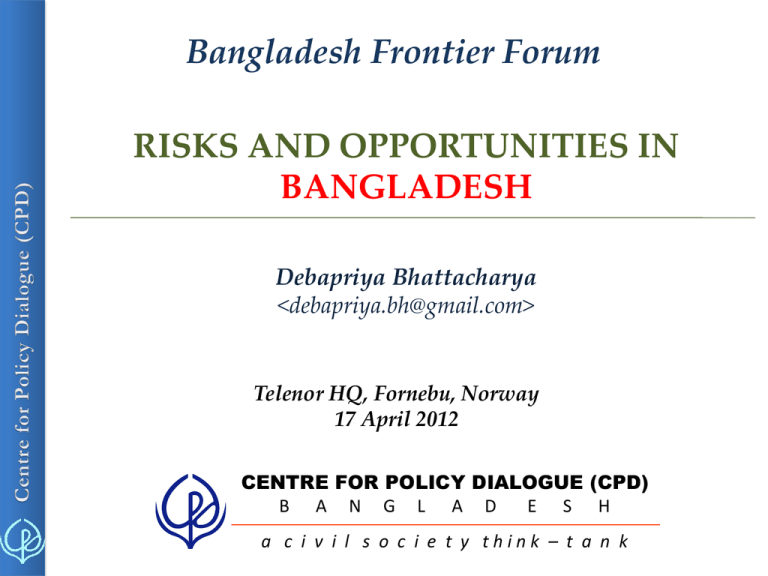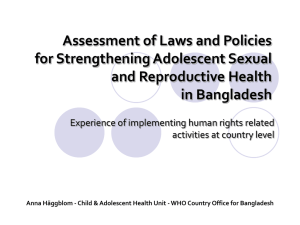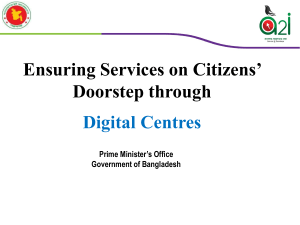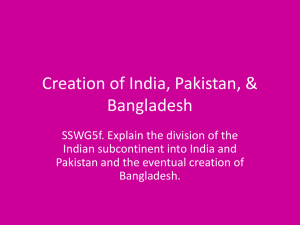Deb Bhattarcharaya Presents Opportunities and Risks
advertisement

Bangladesh Frontier Forum RISKS AND OPPORTUNITIES IN BANGLADESH Debapriya Bhattacharya <debapriya.bh@gmail.com> Telenor HQ, Fornebu, Norway 17 April 2012 CENTRE FOR POLICY DIALOGUE (CPD) B A N G L A D E S H a c i v i l s o c i e t y think – t a n k 2 Bangladesh: Development was possible! • Bangladesh began her journey in 1971 being the “test case of development” as portrayed by Faaland and Parkinson (1976) A number of pessimisms worked against any optimistic review – Large population and high population growth High level of poverty Hit by a devastating war No strategic importance Faaland and Parkinson (1976) concluded “If development could be made successful in Bangladesh, there can be little doubt that it could be made to succeed anywhere else. It is in this sense that Bangladesh is the test case for development”. “For more than four decades, Bangladesh belied the pessimistic prophecies of economists and displayed extraordinary resilience in the face of natural catastrophes and man-made calamities.” (Akbar Ali Khan 2011) Bhattacharya: Risks and Opportunities in Bangladesh 3 Economy is Growing with the rest of the World Source: Calculated from WDI Database BD’s share in World GDP and World GNI has started to rise in recent years. Bangladesh remained steady as the 47th largest economy among 124 countries reported. According to Goldman Sachs report (in 2005), by 2025, Bangladesh may emerge as the 22nd largest economy in the world and will be an important member of N-11. Bhattacharya: Risks and Opportunities in Bangladesh 4 GDP Growth Remained Close to Middle Income Countries Source: Calculated from WDI Database During 1980s Bangladesh’s average GDP growth was a little higher than the world and middle income countries. During the last two decades, it surpassed the global average and remained close to average of middle income countries. Bhattacharya: Risks and Opportunities in Bangladesh 5 GDP Composition: Increasing Role of Modern Sectors Bangladesh Middle Income Countries Source: Calculated from WDI Database Share of modern sector is also increasing. However, compared to the middle income countries, Agriculture remains important source of GDP. Bhattacharya: Risks and Opportunities in Bangladesh 6 Per Capita Purchasing Power Doubled in Three Decades Bangladesh Middle Income Countries Source: Calculated from WDI Database Bangladesh’s per capita purchasing power doubled between 1980 and 2010 (from $677 to $1,488) Per capita purchasing power of middle income countries also doubled (from $2675 to $5992) – the gap did not change. Bhattacharya: Risks and Opportunities in Bangladesh 7 Large Share of Global Poor Bangladesh & World Poverty 1990 (million) Bangladesh & World Poverty 2005 (million) Poverty headcount ratio at $1.25 a day (PPP) (% of population) has been used as the indicator of poverty Source: Calculated from WDI Database In 1990, Bangladesh had 4.3% of the world’s poor population, however, in 2005 this share increased to 5.5% (effect of China) Despite this, Bangladesh poverty rate has declined from 66.8% in 1990 to 49.6% in 2005 Bangladesh has the 5th largest poor population in the world (in 2005 after India, China, Nigeria and Pakistan). Bhattacharya: Risks and Opportunities in Bangladesh 8 Poverty Reduction Accelerated Poverty declined to 31.5% in 2010 from 40.0% in 2005 Gini coefficient for income and expenditure declined from 0.47 in 2005 to 0.46 in 2010 However, consumption gini coefficient declined from 0.33 in 2005 to 0.32 in 2010 Poorest divisions (western parts) performed astonishingly better than the capital and other moderately poor districts Division-wise Poverty Rate Source: HIES 2010 Bhattacharya: Risks and Opportunities in Bangladesh 9 Growing Potential Labour Force Potential Labour Force (Bangladesh) Bangladesh’s Share in Global population and Labour Force Source: Calculated from WDI Database Bangladesh had the 8th largest population in the world in 2010 among 210 reported countries (8th in 1980) though population growth rate decreased (from 2.9% in 1981 to 1.2% in 2010) Bangladesh’s share in global labour force is now almost equal to her share in population. The size of the potential labour force is increasing gradually which is projected to increase in the next two decades as well. Growth rate of labour force has been higher than the population. Bhattacharya: Risks and Opportunities in Bangladesh 10 From an Aid Dependent to a Trade-led Country Bangladesh’s Trade Openness Bangladesh’s Aid receipt as % of GNI Source: Calculated from WDI Database Bangladesh is increasingly becoming a trade-led from an aid dependent country. Bhattacharya: Risks and Opportunities in Bangladesh 11 Leading Manufacturing Exporter among LDCs Bangladesh’s Manufactures exports (% of merchandise exports) Source: Calculated from WDI Database Manufacturing products (e.g. RMG) has become dominant exportable products. Bhattacharya: Risks and Opportunities in Bangladesh Bangladesh’s share in global export is still very low but gradually increasing. As a exporting country, Bangladesh ranked 66th in 2010 among 108 reported countries (74th in 1980). 12 Major Destination of Global Remittances Bangladesh’s Share in Global Workers' remittances Between 1980 and 2010, remittances inflow increases 32 $10.9 billion in 2010 times. Share of remittances inflow also increases from 0.9% to 2.1% Source: Calculated from WDI Database As a remittance receiving country, Bangladesh ranked 7th in 2010 among 163 reported countries (25th in 1980). Bhattacharya: Risks and Opportunities in Bangladesh 13 Moving towards Self-sufficient in Foodgrains Production Per Capita Food Availability Bangladesh’s Population and Foodgrain Production Source: Calculated from BBS and Bangladesh Bank data Bangladesh has achieved higher growth in foodgrain production compared to her population growth. Foodgrain production has doubled in last two decades. Per capita foodgrain availability is also increasing in Bangladesh, from 453 gm in FY92 to 605 gm in FY10 Bhattacharya: Risks and Opportunities in Bangladesh 14 Successful to Navigate through GFC Bangladesh was the only country in the BRICs and N-11 where macro stability components improved. GDP growth only suffered a relatively mild slowdown Bangladesh’s macroeconomic performance has been stable despite the global financial crisis; Remittance flow has remained largely buoyant Export growth has been resilient at double digit Although revenue mobilization has been partially affected but due to strong domestic collection it has been largely offset Bangladesh has come under purview of two sovereign credit rating agencies. Bangladesh was awarded 'BB-' for long term and 'B' for short term by Standard and Poor's and Ba3 by Moody's. Bhattacharya: Risks and Opportunities in Bangladesh 15 Bangladesh in Economic and Political Alliances Bangladesh is well situated in every sense to take advantage of her strategic location – flanked by the two fastest growing economies in the world (China and India). Bangladesh integrate its economy into the global value chain, and become a trade and transportation hub in South and South-East Asia. "In many ways, there lies an important asset for Bangladesh. I believe that Bangladesh has the potential to become Singapore in South Asia.” – Pascal (2011) Bhattacharya: Risks and Opportunities in Bangladesh 16 Satisfactory Progress towards Attaining MDGs Bangladesh’s progress towards achieving MDGs looks promising in most areas: Goal 1: Eradicate Extreme Poverty and Hunger—goal will partially be met • Proportion of population below poverty line • Poverty gap ratio Goal 2: Achieve Universal Primary Education—goal will partially be met • Net enrolment ratio in primary education Goal 3: Promote gender equality and empower women—goal will probably be met • Ratios of girls to boys in primary education • Ratios of girls to boys in secondary education Bhattacharya: Risks and Opportunities in Bangladesh 17 Satisfactory Progress towards Attaining MDGs Bangladesh’s progress towards achieving MDGs looks promising in most areas: Goal 4: Reduce Child Mortality—goal will be met • Under-five mortality rate • Infant mortality rate • Proportion of 1 year-old children immunised against Goal 5: Improve Maternal Health—goal will be met • Maternal mortality ratio (Goal 5) • Contraceptive prevalence rate (Goal 5) Bhattacharya: Risks and Opportunities in Bangladesh 18 Satisfactory Progress towards Attaining MDGs Bangladesh’s progress towards achieving MDGs looks promising in most areas: Goal 6: Combat HIV/AIDS, Malaria and other Diseases • HIV prevalence among population aged 15- 24 years • Deaths of Malaria per 100,000 population • Proportion of children under 5 sleeping under insecticide-treated bed nets (13 high risk malaria districts) • Proportion of children under 5 with fever who are treated with appropriate anti-malarial drugs • Prevalence of TB per 100,000 population • Deaths of TB per 100,000 population • Detection rate of TB under DOTS • Cure rate of TB under DOTS Bhattacharya: Risks and Opportunities in Bangladesh 19 Leader in UN Peacekeeping Mission Bangladesh is the highest troops and police contributing country in UN peace missions with engagement of 10,654 Bangladeshi peacekeepers in troubled regions across the world (10% of total). It was 1988 when Bangladesh's modest contribution began, with 31 officers as part of UNIMOG (UN Iraq-Iran Military Observer Group) in Iraq. Till July 2011, 106 Bangladeshi soldiers have lost their lives. The first Bangladeshi women police contingent has joined the UN mission recently. Bangladeshi peacekeepers so far served in 12 out of 16 UN peacekeeping missions. Bhattacharya: Risks and Opportunities in Bangladesh 20 Growing Trade Relations between Bangladesh and Norway Export and Import between Bangladesh and Norway ( mln $) In five years, between FY06 and FY11, Bangladesh’s export to Norway increased by 6.4 times Textile and Textile articles were the major exported products (96% of total export) Source: Calculated from Export Promotion Bureau and Bangladesh Bank data During the same period, Bangladesh’s import from Norway increased by 3.8 times Electrical machinery, equipments and parts and Wood and articles of wood are the major imported products (89% of total imports) Bhattacharya: Risks and Opportunities in Bangladesh 21 More Scope for Cooperation in ODA and FDI ODA inflow from Norway FY73-FY10 ( mln $) FDI inflow from Norway FY99-FY10 ( mln $) Source: Economic Relations Division (ERD) and Bangladesh Bank data Flow of bilateral ODA is small in Bangladesh from Norway In last 12 years (FY99-FY10) total FDI inflow from was only USD 420 million – mainly to telecommunication sector Total FDI stock as on end of June, 2011 was only USD 142 million Bhattacharya: Risks and Opportunities in Bangladesh 22 Challenges and Risks Remains Breaking the ± 6 per cent threshold of Economic Growth Providing Productive Employment to a Growing Young Labour Force Promoting Economic Diversification (GDP, Export, Employment) for Structural Change Lack of Infrastructure (Communication and energy) Maintaining Macroeconomic Stability Improving Nature of Democracy Ensuring Political Stability Facing Growing Risks arising from Global Exposure Implementing Structural Reforms Adapting the Adverse Impacts of Climate Change Tackle High level of Corruption Bhattacharya: Risks and Opportunities in Bangladesh 23 Bangladesh, Moving Forward Bhattacharya: Risks and Opportunities in Bangladesh 24 Bangladesh, Moving Forward Bad governance "has not prevented Bangladesh from adopting fairly reasonable economic policies and from growing“ – Paul Collier (2007) "Bangladesh shows us that even in circumstances that seem the most hopeless there are ways forward if the right strategies are applied, and if the right combination of investments is made". - Jeffrey D. Sachs (2005) Bhattacharya: Risks and Opportunities in Bangladesh 25 Bhattacharya: Risks and Opportunities in Bangladesh








